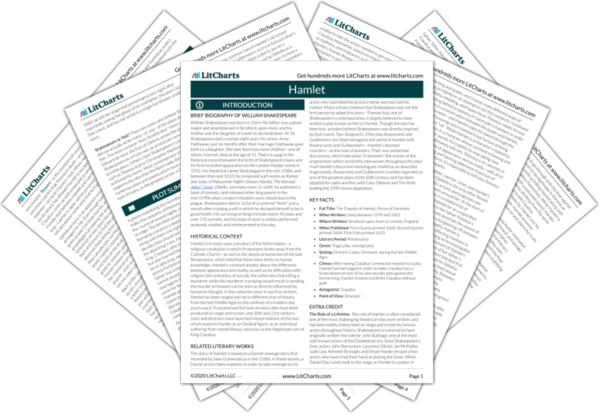Action and Inaction
Hamlet is part of a literary tradition called the revenge play, in which a person—most often a man—must take revenge against those who have wronged him. Hamlet, however, turns the genre on its head in an ingenious way: Hamlet, the person seeking vengeance, can't actually bring himself to take his revenge. As Hamlet struggles throughout the play with the logistical difficulties and moral burdens of vengeance, waffling between whether he should kill Claudius…
read analysis of Action and InactionAppearance vs. Reality
Hamlet is full of references to the wide gulf that often exists between how things appear and how they really are. From Hamlet’s own “craft[ed]” madness to Claudius’s many schemes and plots involving Polonius, Ophelia, Rosencrantz, and Guildenstern to the very foundation of Denmark’s political stability (or lack thereof), things within Elsinore castle are hardly ever as they seem. Hamlet’s characters’ collective desire to make sense of the difference between…
read analysis of Appearance vs. RealityWomen
Though there are only two traditionally female characters in Hamlet—Ophelia and Gertrude—the play itself speaks volumes about the uniquely painful, difficult struggles and unfair fates women have suffered throughout history. Written in the first years of the 17th century, when women were forbidden even from appearing onstage, and set in the Middle Ages, Hamlet exposes the prejudices and disadvantages which narrowed or blocked off the choices available to women–even women of noble…
read analysis of Women
Religion, Honor, and Revenge
Every society is defined by its codes of conduct—its rules about how to act and behave. In Hamlet, the codes of conduct are largely defined by religion and an aristocratic code that demands honor—and revenge if honor has been soiled. As the play unfolds and Hamlet (in keeping with his country’s spoken and unspoken) rules) seeks revenge for his father’s murder, he begins to realize just how complicated vengeance, justice, and honor all truly…
read analysis of Religion, Honor, and RevengePoison, Corruption, Death
When the sentinel Marcellus speaks the line “Something is rotten in the state of Denmark” after seeing the ghost of the former King Hamlet, he is speaking to a broadly-held societal superstition. In medieval times and the Middle Ages—the era in which Hamlet is set—the majority of people believed that the health of a nation was connected to the legitimacy of its king. As Hamlet endeavors to discover—and root out—the “rotten” core of Denmark, he…
read analysis of Poison, Corruption, Death






